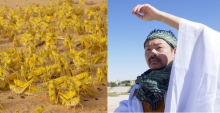Density-dependent mating strategies in locusts

KOUTARO OULD MAENO
Japan International Research Center for Agricultural Sciences, Tsukuba, Ibaraki, Japan
Link to seminar: https://umontpellier-fr.zoom.us/webinar/register/WN_KDx6Xp6_RdOQxKWpi_-OzQ
Social living provides multiple benefits, but it also carries costs such as inter- and intra-sexual conflicts. We can assume that a large group member will make it easy to find mates. However, in reality, 1) finding the best mating partner is difficult, 2) females are frequently harassed by males due to operational sex ratio, and 3) male-male competition is severe. Species-specific mating systems evolve in complex environmental contexts, but how communal animals manage sexual conflicts is poorly understood. Desert locusts, which sometime outbreak in the Sahara Desert, offer fantastic opportunities to study such aspects of mating system. Desert locusts express an extreme form of density-dependent phenotypic plasticity named phase polyphenism. In my talk, I will present recent findings from field and experimental approaches showing how gregarious locusts behaviorally minimize the costs of inter- and intra-sexual conflicts. Our international collaborative research (France, Mauritania, Morocco, Japan) revealed that desert locusts used “Lekking” (male aggregation for mating). I will show how this unique but ubiquitous lekking can meet female’s and male’s sexual demanding at the same time. Further, our results indicate that the mating behaviors of desert locusts are density dependent. I will outline how the mating system of desert locusts evolutionally shaped individual behaviors to mitigate the costs of gregariousness caused by sexual interaction at group-level.
Watch previous seminars on our YouTube channel: https://www.youtube.com/channel/UCrX4IsZ8WIFcDa0ZmC7rcQg
Cyril Piou (UMR CBGP) cyril.piou@cirad.fr


